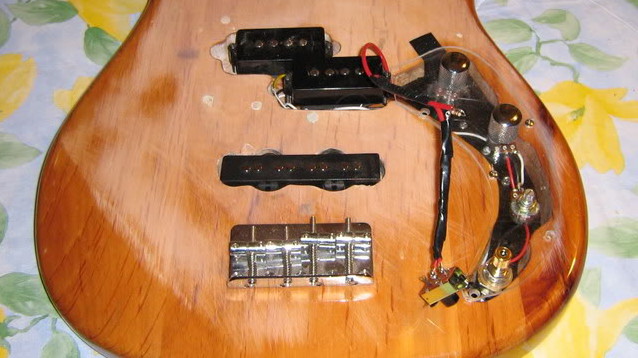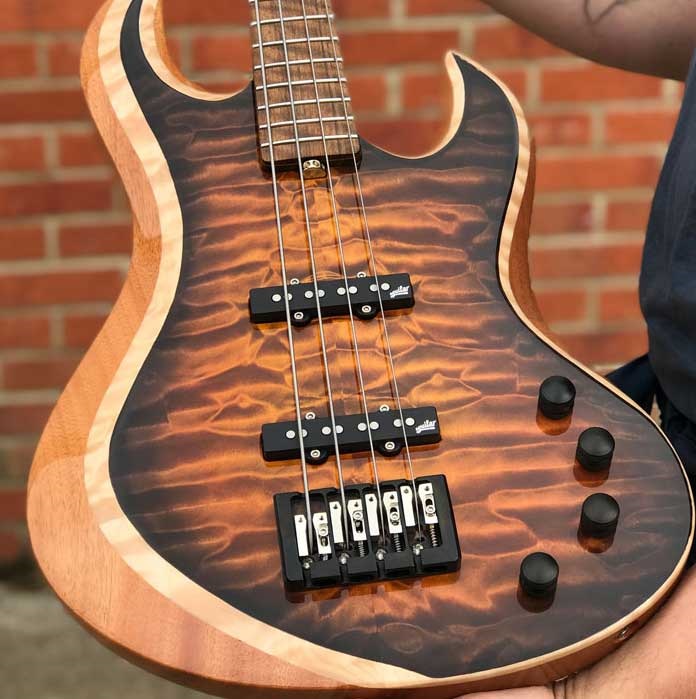Most bass players new to building a bass don’t actually scratch-build the instrument but rather modify an existing one, and that’s fine. However, when the modding starts, sometimes it can end up in disaster where the bass becomes ruined and unplayable from modifying too much stuff. That’s also fine because sometimes the best way to learn is from your mistakes.
Most luthiers have many stories of basses (as well as other stringed instruments) that were over-modded, where the customer brought in the instrument and you could tell from first glance that it was a modding project gone horribly wrong. And in fact, for some luthiers, repair jobs of that sort are the #1 thing they do.
How does one avoid an over-modded bass disaster?
Preventing the disaster from happening doesn’t necessarily involve skill but rather just good old planning.
1. Do you have a plan?
If you don’t, you should.
Get a piece of paper and a pen, and write down every single thing you want to modify on your bass. The act of writing something down physically makes you think about it more, and that’s a good thing.
If you find yourself overthinking the modding process in written form, you know up front that it’s going to be twice as difficult when you actually get around to doing the real thing. Keep it simple on paper, and that will (usually) translate to an easier time when doing the real modding.
2. Don’t do everything all at once
If you are intending to change out the bridge, pickups and tuners, should you do that all at once? Probably not. This isn’t to say you couldn’t, but more often than not it’s better to spread out your mods.
Basically we’re talking about the difference between spending an hour or two working on your bass or the whole day. Sure, you could dedicate a whole day to modding your bass, but that can wear on the nerves and you can lose concentration.
In other words, pace yourself. No rush.
3. Don’t do more than you’re capable of or feel comfortable doing
There is absolutely no shame whatsoever in saying “This is beyond what I can do” when planning your mods.
For example, if you’re not comfortable cutting your own routes, don’t do it. If you’re not comfortable adjusting hole sizes so that your replacement tuners fit, don’t do it. If the wiring scheme for a new preamp you bought looks like a foreign language that you can’t figure out, don’t attempt to install it.
All the above stuff is what you can hire a luthier for. And yeah, you’ll pay more, but it’s worth the cost to get all your stuff installed correctly.
There are some players who find modding easy and others who find it frighteningly difficult. If you feel any, and I mean any fear when it comes to a particular mod, hire a luthier and don’t take the risk of damaging or destroying your bass.
Again, there is no shame whatsoever in admitting there are certain mods you can’t do. Chances are you’re a player first and a modder second. That’s fine. Understanding your own limitations ultimately saves you a lot of hassle, aggravation and money.
Modder beginners should always start with a throwaway bass
As has been said here before, the best way of diving into modding is to start off with a cheap bass, such as a used Squier Precision. And the more FUBAR it is when you first receive it, the better. Why? Because you don’t mind destroying it just to learn how to do your mods. Clip some wires, hack it up, experiment with filing frets (or convert to fretless if you screw up real bad), etc.
Once you learn the ropes with a cheap bass, you’ll be able to more comfortably move on to modding more expensive models.
“But I don’t want to put any money into a cheap bass…”
True, but the money you put into mods for a cheap bass is actually an investment in yourself; you can consider it “paying for home classes” on how to learn modding. When you approach it from that point of view, grabbing a cheap bass for $50 and then putting $150 worth of mods into it is an inexpensive way of learning how to do stuff. If you were to take actual classes on luthiery, you know it would cost a whole lot more. 🙂



I kind of agree with this in principle, but everyone’s different. I bought a new ’76 fretless fender P back in the day. In less than a year I decided to add a second set of P pups. Bought them, hand routed the body for them, added controls and a phase switch. It became an awesome sounding bass. I wasn’t comfortable with anything I did, but I thought it out and was careful. A lot of people can’t afford to buy a bass to practice modding. Just make sure you’re careful and don’t do anything that can’t be undone. And follow your heart…
I’d say that routing is not something you should do to a bass with no experience. If you’re going to rout, learn to rout first. Read some books on the subject. Stay safe.
There was a repair tech in my home town that used to love fixing the wiring jobs I screwed up. Now I do that for others. It’s part of the price of admission. One thing in this article I do not agree with. I’ve done custom routing on too many bass bodies to count and I’ve never botched one. I still get a sinking feeling in my gut every time I pull the trigger on that thing. A healthy fear of what can go wrong is not a bad thing.
If you made a plan to modify your bass to your dream bass this is could be very wrong from the start already as not every bass can be modified or duplicate no mater it was about the looks or the sounds. Your real dream bass should come with less preferences and expectation. Many times I found that going out to find a dream bass is better to build one.
Consider a kit bass from Guitar Fetish (their J Bass kit is a hundred bucks) or for around $150.00, one of the basses from Rondo. I agree, if you’re gonna rout anything, PRACTICE ON SCRAP FIRST, a router is a serious tool that can get away from ya if you’re just attacking blindly. I can’t wire fer shit, but I guess playing with cars and motorcycles made me unafraid to try modding guitars. So if you want to do it, go for it!
Being as I’ve built some pretty sophisticated electronics in my time, I figured swapping pickups and re-doing the grounding and shielding in a bass should be pretty straightforward. I started with a Squier P-J bass that I liked the playability on but especially the bridge pickup simply didn’t do anything for me. Bill Lawrence pickups, a very carefully done routing job to enlarge the bridge pickup pocket and a LOT of time to apply copper foil shielding, and I have a truly awesome sounding and playing bass. Added a pull switch pot to do series/parallel switching on the P-Bass pickup from Bill, which yields a very nice difference in sound. To top it off I installed D-Tuner. The only thing left is to replace the stock bridge with something like a Babicz FCH and I’ll consider this very versatile passive four string bass done. This could also be called a Squier done Right. This was a cheap starter bass that was nice looking, had a nice neck and playability, that just needed some help in the electronics area to make it really work. Mission accomplished. Best of all, it’s dead quiet since the bridge pickup is now an air spaced humbucker. The value of full shielding should also be considered in ANY thorough re-do of a bass.
I admit it I’m a “Modder Sucker” More TOYZ please!!!